Abstract
A necessary condition for agriculture to provide environmental public goods at the level desired by the society is the existence and compliance with appropriate “rules of the game” (institutions). Undoubtedly, institutions are of fundamental importance for agriculture in areas with natural or other specific constraints (ANCs), the new delimitation of which was recommended by the European Commission to all EU member states under the CAP 2014–2020 and which is valid under the CAP 2023–2027. The aim of the study is to indicate the role of institutions in the new institutional economics (NIE) approach in the context of supporting agriculture in ANCs. The specific goals consist of indicating a method for determining the current ANCs in the EU, including Poland; characterizing their current state in Poland, as compared to other EU countries; determining their role in the implementation of the agri-environment-climate (AECM) and organic farming measure under the EU CAP (they are particularly predestined to provide environmental public goods) and also specify the determinants encouraging farmers in ANCs to participate in these measures; assessing the production and economic situation of agriculture in these areas in individual EU countries. The data source was data from the Institute of Soil Science and Plant Cultivation—State Research Institute in Puławy and the Institute of Agricultural and Food Economics—National Research Institute, Agency for Restructuring and Modernization of Agriculture, European Commission FADN—FSDN. Descriptive methods were used to analyze and present the materials. Tabular graphic logistic regression model, the Wald test, the Cox–Snell pseudo-R2 measure and its additional variant proposed by Nagelkerke were used. The study is intended to fill the research gap regarding the determination of the ability of agriculture in ANCs to reconcile the market function, which is reflected in its economic situation, with the provision of environmental public goods to the society. It was determined that in communes with a high saturation of lowland ANCs, farms achieving worse production results in the form of lower wheat yields and lower net income calculated without subsidies per 1 ha of utilized agricultural area (UAA) had a greater tendency to implement AECM and organic farming measure. In most EU countries, agriculture in ANCs is characterized by extensification of agricultural production compared to other agriculture. It generally incurs lower costs and, as a result, obtains lower production effects and income from agricultural activities per 1 ha of UAA. The study provides arguments supporting the thesis that for agriculture in ANCs to achieve satisfactory economic effects and at the same time be able to provide the public with environmental public goods to a wide extent, it is necessary to have public financial incentives in the form of subsidies from the EU CAP.
1. Introduction
Globally, the society increasingly values public goods related to the good condition of the natural environment [1,2]. For its better protection, it uses a wide range of legal, economic and information instruments. It introduces many environmental regulations, offers additional payments and expands the range of forms of information transfer [3,4]. Many of the activities are directed at agriculture, which is increasingly obliged to provide it with environmental public goods in the form of appropriate protection of soil, water, climate, biological diversity and diversified landscape [5,6]. It should be emphasized that one of the most important priorities for the society today is also the maintenance of agricultural areas of high natural value, not only due to the numerous environmental benefits derived from them—including those related to the protection of many valuable natural habitats and rare species of wild animals living there—but also cultural and economic benefits [7]. At the same time, however, there are growing concerns that, in relation to the current and future demand for the goods, their supply from agriculture will be insufficient, especially in the face of changing land use patterns and ongoing climate change [8,9,10]. The concerns are justified by the current trends in agriculture, which, on the one hand, increase the intensity of agricultural production in areas convenient for its development and, on the other hand, abandon it locally on lands least suitable for its development [11,12,13,14]. It is worth emphasizing that both processes degrade the natural environment through increased erosion, compaction, pollution and desertification of soils, additional emissions of greenhouse gases into the atmosphere, spread of chemical pollutants to groundwater and open water bodies, loss of biodiversity and simplification of the structure of landscapes [15,16,17,18]. On the other hand, it is necessary for agriculture to provide environmental public goods in a continuous and stable manner, which is of fundamental importance for ensuring food security for the society [19]. However, the basic features of public goods confirm the belief that in economic reality, their voluntary contributions from agriculture, without support from institutions, are not able to meet the growing society needs in a lasting, stable way and at the desired level [20,21,22,23].
According to Ostrom [24,25], institutions are the rules and strategies used by human beings when interacting in complex and repeated interpersonal situations. According to her, they are understood, enforced and predictable in the society, which achieves the intended benefits by bearing the costs of their constant monitoring. In turn, Acemoglu et al. [26] note that institutions create incentives in an individual to motivate them to invest in their development and also help in the effective allocation of resources on the market. In this context, as Hurwicz [27] claims, it is extremely important to properly define the role, which institutions are to play for an individual on the market, as well as their universal acceptance and trust in the society.
In the context of the influence of institutions on the direction and strength of decisions made by an individual, the new institutional economics (NIE) trend brings significant achievements. In this trend, its ability to achieve economic efficiency is strongly related to formal rules and its ability to adapt to the changing needs, expectations and values in the society, including those related to the provision of environmental public goods, which it is appreciating more and more. Douglass North, one of the creators of the NIE, perceives institutions as “rules of the game” in economic reality; they are the constraints devised by people, which shape their interactions in the society [28,29]. According to him, institutions understood in this way effectively direct the individual to strive for particular economic goals; at the same time, they fully share the values, attitudes, ethical and moral norms cultivated in the society [30,31,32,33,34].
In the case of agriculture, the role of institutions, which effectively support it, should be to ensure its economic viability and to meet additional criteria for its assessment, including primarily those related to the protection of the natural environment. Great readiness and will to implement the activities are visible in the European Union (EU). This is evidenced by its currently most important strategic document, the European Green Deal strategy dated 2019, along with its thematic strategies for 2020–2021, including the soil strategy, the EU biodiversity strategy up to 2030, the strategy from farm to table and the climate change adaptation strategy [35,36,37,38]. It should be emphasized, however, that for the regulations to be successfully implemented on a wide scale in EU agriculture, it is also important to constantly shape farmers’ values and motivation to protect the natural environment.
The European Commission (EC) currently sees great potential for implementing environmental protection through agriculture, conducting agricultural production in areas with natural or other specific constraints (ANCs), which currently cover 57.9% of the total agricultural area in the EU [39]. It should be emphasized that the EC associates the benefits resulting from their support with maintaining the economic viability of ANCs, improving the economic situation of agricultural farms and increasing the awareness and willingness of farms in the areas to protect the natural environment [40].
The study is intended to fill the research gap regarding the determination of the ability of agriculture in ANCs to reconcile the market function, which is reflected in its economic situation, with the provision of environmental public goods to the society. The international literature shows a paucity of results of this type of analysis conducted in relation to the newly designated ANCs in the EU, the delimitation of which was ordered by the EC for all EU countries under the CAP 2014–2020. It should be emphasized that the delimitation is also valid in the EU under the CAP 2023–2027.
The aim of the study is to determine the role of institutions in the context of the new institutional economics (NIE) approach and in the context of supporting agriculture in ANCs in reconciling the income function with the protection of the natural environment. The aim of the study is also to indicate the method and process of designating ANCs in the EU, including Poland. A parallel goal is also to indicate their current status in Poland, as compared to other EU countries, to determine their role in the implementation of the agro-environment-climate measure (AECM) and organic farming under the EU CAP, as well as to specify the determinants encouraging farmers from these areas to participate in environmental measures. In addition, the aim is also to assess the production and economic situation of agriculture in ANCs in individual EU countries on average in the years 2004–2020.
2. Theoretical Background
In the NIE trend, the role of institutions is to strive for the individual to be a permanent part of the society, sensitive to the signals, information, commands and stimuli coming from them. Menard and Shirley [41] emphasize that in the NIE approach, the presence of an institution is necessary for an individual to be successful in their activities on the market because—contrary to the assumptions of neoclassical economics—the trend assumes that they do not have complete information and are therefore characterized by limited rationality when making decisions, which in turn leads to a situation where they do not always choose the best decision available. In other words, they are not able to optimally organize their preferences in relation to all possible alternatives for allocating their own resources, which would be consistent with their and the society’s expectations. Coase [42], the second creator of NIE, fully agrees with this deficiency in neoclassical economics, emphasizing that neoclassicism “becomes more and more abstract over time, and although it purports otherwise, it is in fact little concerned with what happens in the real world”. The same opinion is also presented by Williamson [43], the third creator of the NIE; he points out that in neoclassical economics, the importance of “institutions” for the market is underestimated. In his opinion, this trend focuses on the analysis of individuals striving solely to achieve economic utility from their resources, regardless of the role of the institutional environment in which they operate. In this trend of economics, the fundamental role of institutions is to ensure that people are able to reach a compromise between their own economic well-being and social interests [44,45,46,47].
In the current economic reality, institutions are necessary to effectively and permanently internalize in agriculture these values and patterns of behavior, which are consistent with the goals, which the society strives for. EU agriculture, in the context of providing environmental public goods to the society, directly benefits from the CAP, revised every few years, in which the activities aimed at these goods are gaining more and more importance [48]. This concerns the operation of AECM and organic farming, which have been a permanent part of them for many years and are primarily predestined to provide them [49,50]. Taking the above into account, it is worth emphasizing that the CAP offers agriculture activities thanks to which it is able to provide the society with a number of environmental public goods, including the production of market goods, although this often requires it to incur additional costs and skillfully use its resources and production inputs. Therefore, the question arises regarding the strength of the inclination of agriculture in ANCs to participate in the activities.
In the economic and agricultural literature, there is scientific evidence that the tendency of agriculture, including ANCs, to implement CAP measures serving environmental public goods depends on many factors. It turns out that the possibility of obtaining financial compensation for incurring additional costs of participating in them plays a very important role [51,52,53,54]. In agriculture, the poorer management conditions resulting from the presence of agricultural land with significant natural difficulties for intensive agricultural production [55,56] are an important determinant, which often shapes a higher level of environmental public goods provided. It should be noted that in this context, one of the strengths of the areas is the existence of diverse landscapes, often belonging to the Natura 2000 network, and the frequent presence of farms with extensive organization of agricultural production [7,57,58,59]. It should be added that for farms with extensive organization of agricultural production, the possibility of receiving additional payments for implementing AECM measures and/or organic farming may effectively influence their decisions to stop using conventional agricultural practices. The situation is different for farms with intensive organization of agricultural production; they are generally less likely to decide to implement them. In their case, implementing the activities on a broader scale would often involve such a significant drop in income that it would not be fully compensated by the additional subsidies received in this respect [60,61].
3. Materials and Methods
To achieve the first goal of the analysis, a review of the international literature on the NIE trend was conducted in the context of the role of institutions in the current economic reality. The second aim of the analysis concerned the description of the method and process of determining previous (LFA) and current ANCs in the EU, including Poland. In this context, it should be emphasized that in Poland, the currently applicable delimitation of ANCs was carried out at the request of the Ministry of Agriculture and Rural Development and the EC by the Institute of Soil Science and Plant Cultivation—State Research Institute within the framework of biophysical criteria and as part of the fine-tuning procedure by the Institute of Agricultural and Food Economics—National Research Institute in 2019 [62]. There are currently five ANC zones in Poland: (1) with natural limitations, zone I; (2) with natural limitations, zone II; (3) specific type, zone I; (4) specific type, zone II (foothill); and (5) mountain type.
To achieve the third objective, the characteristics of communes saturated with ANCs in Poland to varying degrees were established. For this purpose, five groups of communes were distinguished. The first three had an equal or greater than 75% share of ANCs in the total UAA. In the first one, such large share resulted from the total presence of zone 1, 2 and/or 3, hereinafter referred to as communes with a high share of lowland ANCs; in the second one, it resulted from the joint presence of zones 4 and/or 5, hereinafter referred to as communes with a high share of foothill and mountain ANCs; and in the third one, it resulted from the joint presence of lowland and foothill ANC zones or mountainous areas, hereinafter referred to as communes with a high share of combined ANCs. The fourth group consisted of communes with a share of ANCs in the total UAA of less than 75%, hereinafter referred to as communes remaining in ANCs. The fifth group included areas from outside ANCs (Figure 1 and Figure 2).

Figure 1.
Schematic diagram of the analysis of agriculture within separate groups of communes depicting the presence and burdensomeness of ANCs in Poland (Source: Own study, 2023).
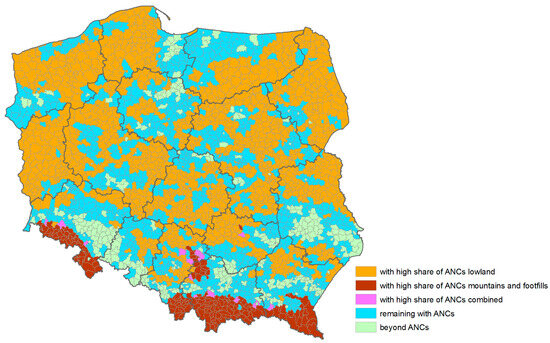
Figure 2.
Distribution of communes designated by the degree of saturation and specificity of ANCs in Poland (Source: Own study, 2023).
In separate groups of communes, the diversity and value of their landscape were first established. For this purpose, data from the Institute of Soil Science and Plant Cultivation—State Research Institute in Puławy and the Institute of Agricultural and Food Economics—National Research Institute were used regarding the share of permanent grasslands, forests and waters in the total area and the state of agriculture characterized by extensive organization of agricultural production carried out in the surroundings of valuable components of the natural environment and meeting EU requirements under the concept of high nature value farmlands (HNVf). It should be noted that the delimitation of HNVf areas was carried out at the request of the Ministry of Agriculture and Rural Development by the Institute of Soil Science and Plant Cultivation—State Research Institute and by the Institute of Agricultural and Food Economics—National Research Institute in 2018, in accordance with the EC guidelines contained in the document entitled “Working Document, Practices to identify, monitor and assess HNF farming in RDPs 2014–2020” [63,64]. Then, in the analyzed groups of communes, the organizational features of their agriculture were determined based on data from the Agency for Restructuring and Modernization of Agriculture, which is a public institution implementing EU CAP payments in Poland. The data came from applications submitted by 1345.2 thousand and 1252.0 thousand farms, respectively—beneficiaries of the CAP 2014–2020—for direct payments in 2016 and 2022. On their basis, they also determined the state of the area supported under the AECM measure and organic farming in 2022.
Next, the direction and strength of the influence of factors underlying the decision of farms from communes with a high share of lowland ANCs to implement AECM and/or organic farming measure were determined (Figure 3). For this purpose, a logistic regression model was used, based on data from farms participating in these two activities against the background of other farms, which kept accounts for the Polish FADN continuously from 2016 to 2021. It should be emphasized that the models are a common tool used in international literature to identify the factors determining farmers’ willingness to participate in the activities indicated here [65,66].
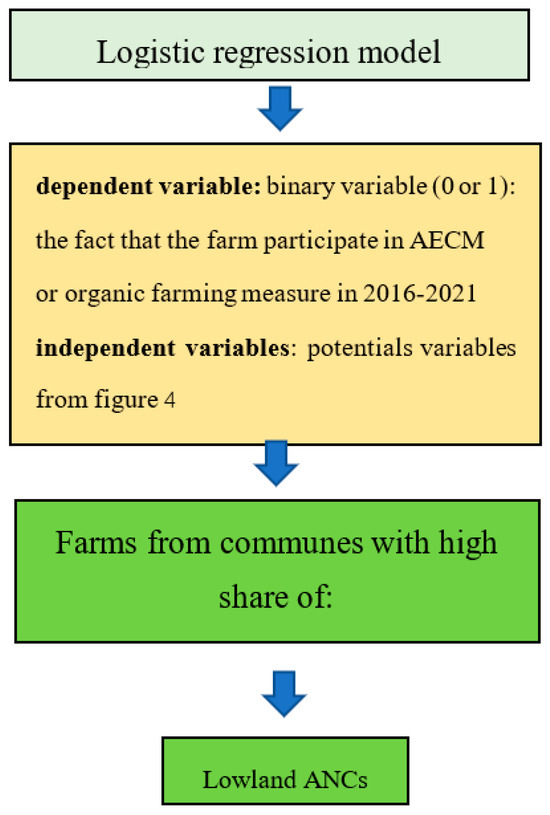
Figure 3.
Schematic diagram of the analysis of factors indicating the tendency of farms from communes with a high share of lowland ANCs to implement environmental activities under the EU CAP (Source: Own study, 2023).
In the logistic regression models, the dependent variable was treated as a qualitative (dichotomous) variable, which took the value of 1 if the farm participated in the AECM measure and/or organic farming continuously from 2016 to 2021 and 0 if the farm participated in neither of the activities in the analyzed 6-year period. This division of the analyzed groups of farms allowed for the analysis of two extreme groups of farms in terms of their tendency to implement environmental activities. Using this model, the answer to the following question was obtained: How does changing the selected (statistically significant) explanatory variable by one unit affect the farm’s willingness to participate in the analyzed environmental activities in communes with a high share of lowland ANCs?
In the logistic regression model, the probability (P) of occurrence of the expected situation (1) for the explained variable is described by a function, which is the distribution function of logistic distribution in the form P = f(β)= and finally takes the form [67]
where is the probability that the variable y will assume a value equal to 1 for the values of explanatory variables for i = 0, …, k is the regression coefficient; are the explanatory variables in quantitative (continuous) or qualitative (binary) terms.
The model was estimated using the Statistica program, and to assess its quality, the likelihood ratio test, the Wald test, the Cox–Snell pseudo-R2 measure and its additional variant proposed by Nagelkerke were used. As potential explanatory variables subject to further statistical assessment, those relating to human capital and organizational features and the economic situation of farms, as well as social capital and landscape features and their natural management conditions, were taken into account (Figure 4). It should be emphasized that the analyzed potential explanatory variables often determined the direction and strength of farmers’ willingness to participate in the activities indicated here in other EU countries [54,61,68,69].
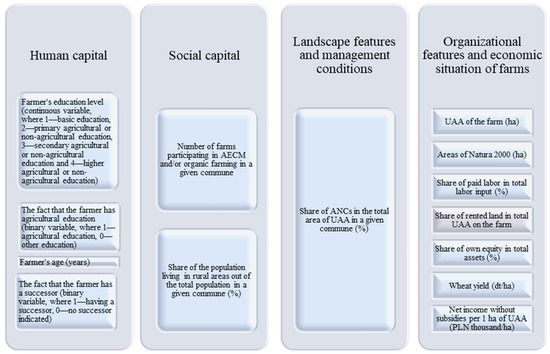
Figure 4.
Scheme of explanatory variables used in the statistical analysis within logistic regression models for farms in communes with a high share of lowland ANCs (Source: Own study, 2023).
The last part of the study assessed the production and economic situation of farms with and without ANCs in EU countries on average in 2004–2020. For this purpose, data published by the European Commission on its website as part of the FADN—FSDN public information system were used [70]. It should be emphasized that data from farms collected within the FADN system are considered the best available set of data on agriculture in EU member states [58,71]. It should also be added that the data in 2020 were representative of approximately 4022.7 thousand farms in the EU [72]. In individual EU countries, the following were established, among others: average wheat yields and milk yields, total costs per 1 ha of UAA (EUR/ha), as well as farm income per 1 ha of UAA and the value of operational subsidies received, including subsidies for implemented environmental measures per 1 ha of UAA (EUR/ha).
4. ANCs—Past and Present Methods of Their Designation in the EU, Including Poland
In the EU, farms located in areas with unfavorable conditions for agricultural production have been supported by subsidies under the EU CAP since 1975 [73]. In 1975–2018, the EU supported areas with natural limitations, including mountain areas and areas at risk of loss of continuity of agricultural use, as well as rural areas designated at risk of depopulation by individual member states [74,75].
In Poland, areas with unfavorable economic conditions (formerly LFA areas) were designated for the first time in 2003–2006 based on the national agricultural production area valorization index (APAV) developed on the basis of soil and agricultural map data at a scale of 1:25,000 and based on demographic criteria, such as population density and the percentage of the population employed on farms. The lowland areas designated in this way constituted 51.6% of the agricultural area (UR) in Poland. After taking into account foothill areas (2.9% of the UAA), where more than half of the UAA is located 350 m above sea level, and mountain areas (1.6% of the UAA), where more than half of the UAA is located 500 m above sea level, in total, the areas in Poland constituted 56.1% of the UAA and constituted the basis for the payment of LFA subsidies in 2004–2018.
In 2003, the European Court of Auditors (ECA) drew attention to the highly diversified and incomparable rules for designating the then LFA areas between member states and the ineffective targeting of aid for the protection of agricultural land use. The ECA argued that social support for preventing depopulation of rural areas is already provided through other channels, and the rules for designating these areas should be adopted at the EU level and cover only biophysical constraints. New general rules common for all EU member states for the designation of areas with natural or other specific constraints (ANCs) implementing the ECA recommendations were detailed during consultations with experts and made public in the form of framework guidelines [76,77,78]. The methodology for determining new ANCs was based on the principle of Liebig’s limiting factor, according to which natural limitations in agricultural production are considered significant when any of the several biophysical criteria listed in the EC guidelines exceeds an established threshold value, which is common for all EU countries. Other minor restrictions and their severity are then not taken into account, and eligibility is binary (the area is eligible or not for ANC designation). The areas qualifying as ANCs are added up in the lowest level administrative units. As a result, entire administrative units are included in ANCs, in which at least 60% of the UAA is classified after meeting the threshold value of at least one biophysical criterion.
In Poland, lowland ANCs with natural difficulties—designated in 2013–2018 and in force since 2019—constitute 47% of the UAA. Moreover, lowland ANCs with specific difficulties and of high natural and tourist value constitute 7%; updated ANCs with specific difficulties in foothill areas constitute 3.0%; and mountain ANCs constitute 1.7% of the total UAA. In Poland, ANCs currently constitute 57.8% of the total agricultural area [79].
It should be emphasized that in Poland, relatively small changes among the areas designated within the former LFA areas based on the national APAV index and within the current ANCs based on expert findings—uniform throughout the EU—facilitated the adoption of ANCs among Polish farmers and confirmed the objective nature of the previous national criteria used for their designation. The replacement of LFA areas with ANCs has not been smooth in all EU countries. For example, in 2018, in southwestern France, there were street protests by farmers dissatisfied with the potential loss of subsidies as a result of limitation of the area of ANCs compared to the previous LFAs [80]. In Spain, the need to include crops on the country’s numerous terraces as a separate category of biophysical difficulties has been documented because not all such terraces meet the criterion of a slope of ≥15% under the ANCs biophysical criteria [81].
5. Indication of the Current State of ANCs in Poland, as Compared to Other EU Countries, as Well as Determination of Their Role in the Implementation of Selected Environmental Activities under the EU CAP
In the EU, including Poland, natural management conditions are an important factor differentiating the possibility, direction and scale of agricultural production. They are characterized by spatial variability and a large share of ANCs. In the EU, the area of ANCs currently constitutes 57.9% of the total area of the UAA [39]. Among them, ANCs with natural handicaps predominate (32.6%), followed by mountain ANCs (17.1%) and those with specific handicaps (8.2%). It should be noted that in Poland, the share of ANCs is close to the EU 27 average (58.7%); among them—as mentioned in the previous chapter—lowland ANCs with natural handicaps predominate (47.0%). Malta and Luxembourg have by far the largest share of ANCs, each accounting for 100% of the total agricultural area. Finland (99.6%), Latvia (92.9%) and Portugal (90%) have only a slightly smaller share of the areas (Figure 5 and Figure 6) [39].
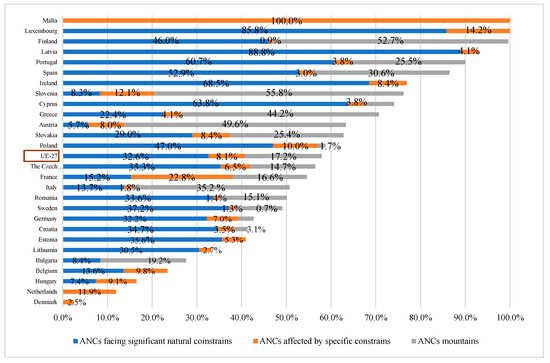
Figure 5.
Share of ANCs in the total area of agricultural land in the EU 27 countries in 2019 (Source: Own study, based on Ref. [39]).
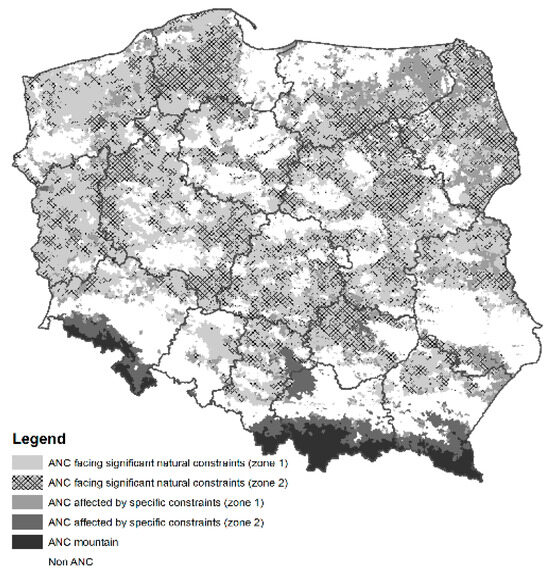
Figure 6.
Distribution of ANCs designated by their specificity in Poland (Source: Own study, based on Refs. [62,82]).
In Poland, among communes with a high share of ANCs (at least 75% of the total area of UAA), the share of communes with a high share of lowland ANCs is 85.9%; the share of communes with a high share of foothill and mountain ANCs is 13%; and the share of communes with a high share of lowland and foothill or mountain ANCs is 1.1%. The basic environmental advantage of communes with a high share of lowland, foothill and mountain ANCs and combined ANCs—as compared to communes, which are the reference point—is the presence of more diverse and naturally valuable landscapes. They are characterized by a large share of permanent grasslands, forests and waters in the total area. Moreover, there is a large share of extensive HNVf UAA of moderate, high and particularly high natural value (Table 1).

Table 1.
Number, management conditions and environmental values of communes with different saturation and specificity of ANCs in Poland (Source: Own study, 2023).
In Poland, even though many areas are characterized by difficult conditions for agricultural production, they significantly strengthen the production potential of domestic agriculture. In 2022, the largest number of farms operated in communes with a high share of lowland ANCs, i.e., 542.3 thousand, and they constituted 43.3% of their total number in the country. There were significantly fewer farms in communes with a high share of foothill and mountain ANCs and ANCs combined, 69.8 and 8.5 thousand farms, respectively. However, in communes remaining in ANCs and without ANCs, their numbers were 480.3 and 151.1 thousand, respectively (Table 2). It should be added that in 2010–2022, in all analyzed groups of communes, there was a decreasing trend in the number of farms (Figure 7).

Table 2.
Organizational features of agriculture in communes with different saturation and specificity of ANCs in Poland in 2022 (Source: Own study, based on Ref. [83]).
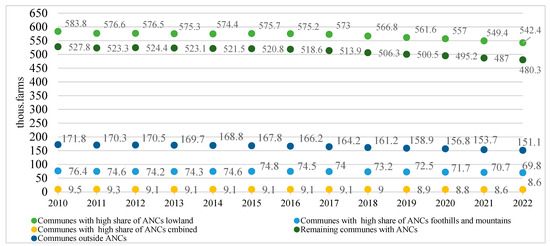
Figure 7.
Number of farms (thousands) in communes with different saturation of ANCs in Poland in 2010–2022 (Source: Own study, based on Ref. [83]).
In communes with a high share of lowland ANCs, 6270.8 thousand ha of agricultural land is currently in use, including 4596.4 thousand ha of arable land and 1578.1 thousand ha of permanent grassland. In communes with a high share of foothill and mountain ANCs, a total of 386 and 48.6 thousand ha of UAA are used, respectively. It is worth adding that in communes with a high share of foothill and mountain ANCs, permanent grasslands prevail in the UAA structure. On the other hand, in communes outside the ANCs, 1754.8 thousand ha of agricultural land is used, including 1591.6 thousand ha of arable land and 93 thousand ha of permanent grassland (Table 2).
In the designated communes with different saturation of ANCs, the share of the total area supported under the AECM and organic farming measures in the total area of agricultural land differed significantly in 2022. It was the highest in communes with a high share of foothill, mountain and lowland ANCs and amounted to 23.6 and 15.8%, respectively. In turn, in communes with a high share of ANCs, the total amount was 6.8%. On the other hand, in communes remaining in ANCs and without ANCs, it was 8.5 and 5.5%, respectively (Table 3; Figure 8, Figure 9 and Figure 10). It turns out that in Poland, farms with greater natural difficulties to manage are more willing to undertake activities specifically aimed at protecting the natural environment. As a result, they contribute more to the provision of a wide range of environmental public goods to the society.

Table 3.
Share of the area supported under the AECM and organic farming measures in the total area of agricultural land in communes with different saturation and specificity of ANCs in 2022 (Source: Own study, based on Ref. [83]).
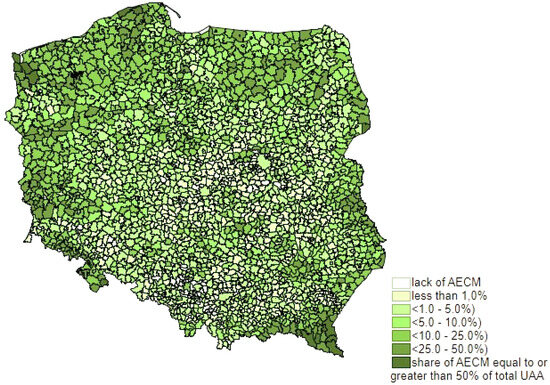
Figure 8.
Share of AECM area in total UAA in Poland by commune in 2022 (Source: Own study, based on Ref. [83]).
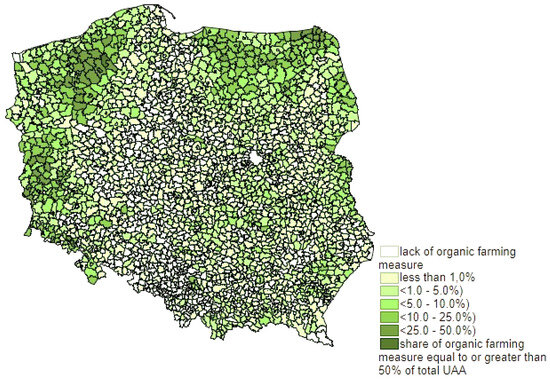
Figure 9.
Share of organic farming measure area in total UAA in Poland by commune in 2022 (Source: Own study, based on Ref. [83]).
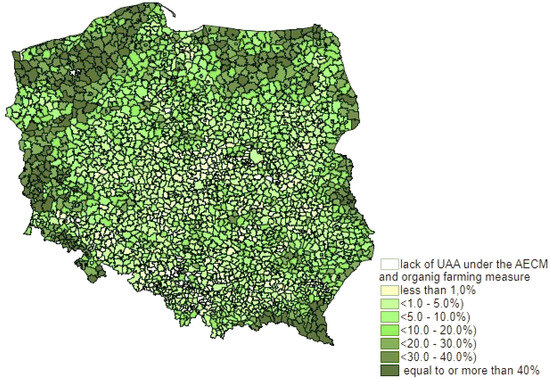
Figure 10.
Share of AECM and organic farming measures in total UAA in Poland by commune in 2022 (Source: Own study, based on Ref. [83]).
6. Factors Determining Participation in Environmental Activities in Lowland, Foothill and Mountain ANCs in Poland
This section characterizes the direction and strength of the influence of statistically significant explanatory variables on the willingness (probability) of farms from communes with a high share of lowland ANCs to undertake environmental measures. For this purpose, logistic regression modeling was used. The obtained parameter values and their statistical significance were subjected to statistical analysis based on the Wald test, and the likelihood ratio (LR) and odds ratios (exp(β)) were established. In turn, the Cox–Snell pseudo-R2 statistic and its modification established by Nagelkerke were used to assess the degree of explanation of variability in the variable explained by the model (Table 4). Ten of the thirteen explanatory variables taken into account in the model turned out to be statistically significant (ρ < 0.05).

Table 4.
Estimated parameters of the logistic regression model (lowland ANCs) (Source: Authors’ own work in Statistica version 13.3 based on Refs. [84,85]).
A higher level of farmers’ education had a positive impact on the tendency of farms to participate in environmental activities. The variable, as indicated in the research method, was set in the model as a continuous variable, for which the value of 1 meant that the farmer had primary education, and the value of 4 indicated higher agricultural or non-agricultural education. In the case of this variable, the odds ratio (exp(β)) of taking action was 1.51. In lowland ANCs, the fact that a farmer had agricultural education was also of great importance, where exp(β) = 1.20. Moreover, in their case, a higher share of ANCs in the total UAA (exp(β) = 1.03) and an increase in the UAA in Natura 2000 areas (exp(β) = 1.01) also had a positive impact.
In lowland ANCs, a farm managed by an older farmer had an increased chance of participating in environmental activities. In such case, exp(β) was 1.01. Moreover, it turned out that each additional farm participating in the analyzed activities in a given commune resulted in an increase in the chance of implementing them in another farm. For this variable in lowland ANCs, exp(β) = 1.02. The same situation was related to having a larger agricultural area on the farm. In this case, exp(β) was 1.01.
In the case of farms in lowland ANCs, the increase in the share of own equity in total assets (exp(β) = 0.97), the increase in wheat yields (exp(β) = 0.98) and the increase in net income (exp(β) = 0.88) had a negative impact on the chances of participation in environmental activities.
7. Production and Economic Situation of Farms in ANCs Compared to Other Farms in EU Countries in 2004–2020
Figure 11 shows the wheat yields in individual EU 27 countries on average in 2004–2020, divided into farms with and without ANCs. Comparing wheat yields in the two groups of farms, it was found that wheat yields on ANC farms were higher as compared to non-ANC farms only in Estonia (by 3.0%) and in Croatia (by 2.1%). In other countries, this relationship was reverse. The greatest differences were recorded in Bulgaria, where wheat yields on farms in ANCs were lower by almost 33%. Average yields in the EU 27 were lower on farms in ANCs (43.5 dt/ha) than on comparable farms (48.9 dt/ha) by 12.4%.
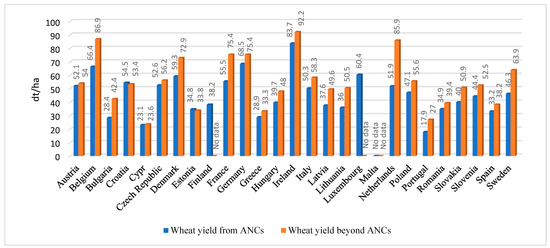
Figure 11.
Wheat yield of farms in ANCs compared to farms in other EU 27 countries on average in 2004–2020 (Source: Own study, based on Ref. [70]).
Analyzing the differences in the milk yield of cows, differences were also found to the detriment of farms in ANCs (Figure 12). Only in three EU 27 countries did farms in ANCs have higher milk productivity; these included Greece (by 6.0%), Estonia (by 5.6%) and Latvia (by 3.9%), respectively. In the remaining 24 countries, farms located in regions not covered by ANCs had higher rates. The differences ranged from 1.1% in Austria to 42.5% in Italy in favor of non-ANC farms.
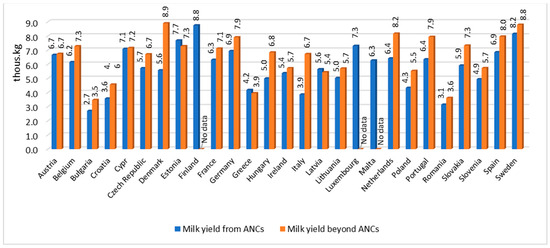
Figure 12.
Milk yield (thousand kg/year) of farms in ANCs compared to other farms in the EU 27 countries on average in 2004–2020 (Source: Own study, based on Ref. [70]).
Figure 13 shows the total costs per 1 ha of UAA. The analysis indicated that, on average, the costs on farms in ANCs were generally much lower than on other farms. Only in Austria, the costs were 3.3% higher on farms in ANCs. In the remaining EU 27 countries, the same relationship was found as in relation to the average, although the strength of the differences to the detriment of farms in ANCs varied. The largest differences were observed in Belgium (65.5%) and the Netherlands (62%).
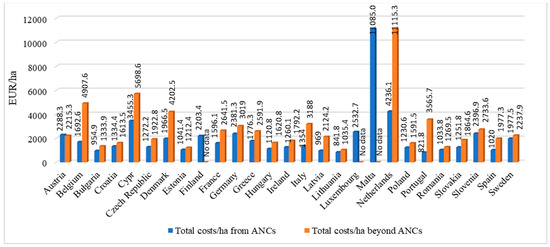
Figure 13.
Total costs per 1 ha of UAA on farms in ANCs compared to other farms in the EU 27 countries on average in 2004–2020 (Source: Own study, based on Ref. [70]).
The analysis also covered the development of income per 1 ha of UAA on farms depending on whether production was carried out in ANCs (Figure 14). On average, in 2004–2020, the median calculated for farms in ANCs (EUR 472.3/ha) was almost 10% lower than for other farms (EUR 516.4/ha). Only in 9 out of 27 EU countries, the average income per 1 ha of UAA on farms with ANCs was higher than on farms without ANCs. However, it must be emphasized that in their case, the favorable situation was largely due to the larger operating subsidies received, including environmental subsidies per 1 ha of UAA (Table 5).
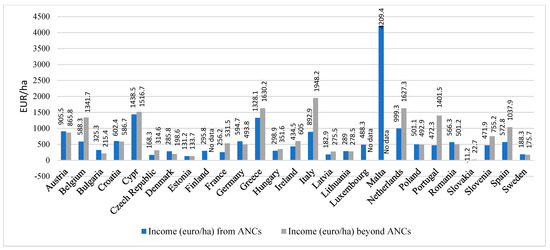
Figure 14.
Income (EUR/ha) of farms in ANCs compared to other farms in the EU 27 countries on average in 2004–2020 (Source: Own study, based on Ref. [70]).

Table 5.
Operating subsidies, including environmental subsidies (EUR/ha) and the direction of differences net income without operating subsidies and in the amount of environmental subsidies received by farms in ANCs compared to other farms in the EU 27 countries on average in 2004–2020 (Source: Own study, based on Ref. [70]).
Table 5 shows the operational subsidies received—including environmental subsidies—per 1 ha of agricultural land in individual EU 27 countries depending on the presence of farms in ANCs. Analyzing their level, it was found that, on average, in farms in ANCs, it was almost 30% higher than in farms not covered by ANCs. Only in two countries did non-ANC farms have higher operating subsidies per 1 ha of UAA: in Italy (by 42.6%) and in Portugal (by 32.4%). In other countries, farms in ANCs were characterized by a higher level of operating subsidies per 1 ha of UAA. The largest difference in favor of farms in ANCs was found in Sweden, where the farms received 70% higher subsidies.
In the EU 27, the average environmental subsidies (agri-environmental and under ecological measures) per 1 ha of UAA were two times higher on farms in ANCs than on reference point farms. The largest differences were definitely found in Germany, where average value was over four times higher on farms located in areas with ANCs. Only in Portugal and Slovenia were non-ANC farms characterized by higher environmental payments: by 8.6 and 32.9%, respectively.
8. Discussion
The obtained research results can be compared with others. Wittstock et al. [54] examined farmers’ decisions regarding agri-environmental schemes using the example of Saxony in Germany. They pointed out that economic factors are not always crucial. Farmers’ practical experience is important. Our research also paid attention to aspects related to the farmers, such as their level of education and the presence of other farmers. They turned out to be crucial when deciding to participate in agri-environmental programs. Russi et al. [61] examined the factors influencing farmers to undertake agri-environment activities based on the example of Baden-Württemberg in Germany. It turned out that most farmers decided to join an agri-environmental program based on a combination of extrinsic motivations (i.e., monetary incentives) and internal motivations (i.e., ethical reasons). In our research, both types of incentives were considered important.
Lakner et al. [65] used a multinomial logit model in their study to estimate the determinants of farmers’ decisions to protect grasslands. Attention was drawn to additional costs in the implementation of agri-environmental programs, which are the main barrier. In our research, we also used a model solution to determine the factors determining farmers’ decisions. Paulus et al. [66] used a regression model in their study to determine farm characteristics and environmental variables in the decisions made regarding agri-environmental programs. It has been shown that the set of important variables may vary depending on the type of program. We also used a regression model in our research. The range of features examined was greater. The conclusions, of course, can be applied to farms located in Poland and cannot be applied to farms in other countries.
Hodge et al. [68] examined the alignment of agricultural and nature conservation policies in the European Union. The Natura 2000 area was a subject of study. It was found that a separate nature protection policy did not stop the loss of biodiversity. Adaptive action is therefore necessary, including a further shift of funds from the general support for farmers to payments targeted at biodiversity objectives. Support is required on a larger scale, as is the adoption of an ecosystem approach. In our research, we found a significant impact of support and additional payments on the decisions made. These types of payments were important in supporting farms, which had worse economic conditions.
Früh-Müller [69] examined the spatial correlation of agri-environmental measures with high levels of ecosystem services. I carried out my research on the basis of two Saxon municipalities in Germany (Wetterau and Vogelsberg, Federal State of Hesse) with contrasting models of environmental and socio-economic conditions, in which it was shown that the mechanisms causing the adjustment in spatial patterns should differ in the case of regulatory and motivational systems. Agri-environmental measures have been shown not to motivate farmers to provide a wider range of ecosystem services. Incentive programs must take into account socio-economic information on the factors influencing the decision making of farmers and land managers. In our research, we tried to find universal factors. Of course, the model results apply to all municipalities in Poland. As suggested, it may be necessary to use various instruments to help motivate farmers to participate in agri-environmental programs.
The obtained results confirm the belief that the market is not able to sufficiently ensure that agriculture in ANCs can reconcile the market function with the provision of environmental public goods. It should be said with a high degree of certainty that if left to its own devices, agriculture would depreciate many non-market values valued by the society, especially those related to the protection of the natural environment. Therefore, in order to remedy the situation, it is necessary to look for the values, which should guide its actions. Without doubt, in this situation, effectively operating institutions are of fundamental importance, as they are able to identify and direct a number of internal motivations in the economic reality. In addition to supporting the achievement of satisfactory economic effects, institutions are also able to strengthen the sense of honesty, justice and social responsibility in the decisions made.
In the current economic reality, characterized by high turbulence and complexity of the processes taking place in it, formal and non-formal institutions functioning efficiently are particularly necessary for agriculture to ensure its achievement of personal economic benefits and benefits for the society through the possibility of sustainable provision of a wide range of public goods related to the protection of the natural environment [86,87,88,89,90]. However, it should be emphasized that, especially in the case of agriculture in ANCs, the dynamic transformations taking place in its environment require the institutions to constantly search for new tools, which will encourage them to take ambitious environmental action in the conditions of constantly growing competitive pressure. We are talking here about the measure of AECM and organic farming; they are primarily dedicated to providing the society with a wide range of environmental public goods. It should be emphasized that by implementing the activities, farms contribute in a unique way to ensuring sustainable and highly biologically diverse agricultural ecosystems, and they also have a positive impact on the resilience of agriculture to the effects of climate change, at the same time allowing the society to consume safe and healthy food and also providing many esthetic, recreational and cultural benefits for the area while maintaining its diversified landscape, which in turn makes it more attractive and supports the development of agritourism [91]. Therefore, the activities also have a positive impact on stimulating local economic activity and increasing employment [92]. However, it is necessary to constantly support this process not only by increasing the area covered by the activities but also by avoiding a situation in which some farms stop using them after the end of the statutory implementation period [93]. In this context, the role of institutions in finding a balance in agriculture between providing environmental public goods and ensuring satisfactory income from agricultural activities is also important. This state of affairs should certainly concern agriculture in ANCs in particular.
9. Conclusions
The research conducted allows for several conclusions and generalizations:
- There is no doubt that institutions should ensure norms, rules, principles and incentives, so that the supply of public goods from agriculture with natural difficulties is satisfactory for the society. This situation is exceptionally important in the context of Polish agriculture, which often conducts agricultural activities in difficult or even particularly difficult conditions and with various specific restrictions within ANCs. An important opportunity to support agriculture in the areas is created by AECM and organic farming. In Poland, the activities in 2022 were implemented in the vast majority of communes in ANCs, especially in communes with a high share of lowland ANCs.
- Based on the logistic regression model, it was determined that in communes with a high saturation of lowland ANCs, farms achieving worse production results in the form of lower wheat yields and lower income calculated without subsidies had a greater tendency to implement AECM activities and organic operational farming per 1 ha of UAA. On the other hand, the farmers’ characteristics related to their better education increased the chance of participating in the activities. Another favorable factor also turned out to be a greater share of people living in rural areas in the total population of communes, a greater share of ANCs in the total UAA and a greater presence in the immediate vicinity of other farms involved in the implementation of environmental activities, as well as a greater presence in the beneficiary’s area of agricultural land and the fact of being located in Natura 2000 areas.
- It should be emphasized that in most EU countries, agriculture in ANCs is characterized by extensification of agricultural production compared to other agriculture. It generally incurs lower costs and, as a result, obtains lower production effects and income from agricultural activities per 1 ha of UAA. It should be added, however, that the revenues would be much lower if they were exempted from operating subsidies, including those related to the implementation of environmental activities.
- The study provides arguments supporting the thesis that for agriculture in ANCs to achieve satisfactory economic effects and at the same time be able to provide the public with environmental public goods to a wide extent, it is necessary to have public financial incentives in the form of subsidies from the EU CAP. It is also necessary to have informal institutions in the form of farmers’ abilities, values and motivations shaped by the society, often including the local environment, and resulting from the acquired knowledge, skills and commitment.
- The research conducted showed differences in individual EU countries in terms of agriculture and areas with worse economic conditions. We suggest that political instruments supporting such areas should be more adapted to the conditions in individual countries. Moreover, there are also differences within individual countries, not only at the level of voivodeships but also at the level of municipalities. It is therefore necessary to better match the instruments to socio-economic and environmental characteristics.
Author Contributions
M.Z.: Conceptualization, Formal analysis, Methodology, Resources, Supervision, Writing—original draft; A.Ł.: Formal analysis, Resources, Validation; P.K.: Resources, Software, Validation; A.Ż.: Formal analysis, Project administration, Validation, Writing—original draft; T.R.: Funding acquisition, Writing—review & editing. All authors have read and agreed to the published version of the manuscript.
Funding
This research received no external funding.
Data Availability Statement
Data are contained within the article.
Conflicts of Interest
The authors declare no conflict of interest.
References
- Gerowitt, B.; Isselstein, J.; Marggraf, R. Rewards for ecological goods—Requirements and perspectives for agricultural land use. Agric. Ecosyst. Environ. 2003, 98, 541–547. [Google Scholar] [CrossRef]
- Vianni, F. Agriculture and Public Goods. The Role of Collective Action; Springer: Berlin/Heidelberg, Germany, 2014. [Google Scholar]
- Reed, M.S.; Moxey, A.; Prager, K.; Hanley, N.; Skates, J.; Bonn, A.; Evans, C.D.; Glenk, K.; Thomson, K. Improving the link between payments and the provision of ecosystem services in agri-environmental schemes. Ecosyst. Serv. 2014, 9, 44–53. [Google Scholar] [CrossRef]
- Wiśniewski, Ł.L.; Rudnicki, R.; Chodkowska-Miszczuk, J. What non-natural factors are be-hind the underuse of EU CAP funds in areas with valuable habitats? Land Use Policy 2021, 108, 105574. [Google Scholar] [CrossRef]
- Ahtiainen, H.; Pouta, E.; Liski, E.; Myyra, S. Importance of economic. Social and environmental Objectives of Agriculture for Stakeholders—A Meta-Analysis. Agroecol. Sustain. Food Syst. 2015, 39, 1047–1068. [Google Scholar] [CrossRef]
- Blackstock, K.L.; Novo, P.; Byg, A.; Creaney, R.; Juarez Bourke, A.; Maxwell, J.L.; Tindale, S.J.; Waylen, K.A. Policy instruments for environmental public goods: Interdependencies and hybridity. Land Use Policy 2021, 107, 104709. [Google Scholar] [CrossRef]
- Sutcliffe, L.M.E.; Batary, P.; Kormann, U.; Baldi, A.; Dicks, L.V.; Herzon, I.; Kleijn, D.; Tryjanowski, P.; Apostolova, I.; Arlettaz, R.; et al. Harnessing the biodiversity value of central and Eastern European farmland. Divers. Distrib. 2014, 21, 722–730. [Google Scholar] [CrossRef]
- Cooper, T.; Hart, K.; Baldock, D. Provision of Public Goods through Agriculture in the European Union; Institute for European Environmental Policy: Bruxelles, Belgium, 2009. [Google Scholar]
- Kuhmonen, T. Systems view of future of wicked problems to be addressed by the Common Agricultural Policy. Land Use Policy 2018, 77, 683–695. [Google Scholar] [CrossRef]
- McDowell, R.W.; Kaye-Blake, W. Viewpoint: Act local. effect global; Integrating farm plans to solve water quality and climate change problems. Land Use Policy 2023, 129, 106670. [Google Scholar] [CrossRef]
- Renwick, A.; Jansson, T.; Verburg, P.H.; Revoredo-Giha, C.; Britz, W.; Gocht, A.; Mc Cracken, D. Policy reform and agricultural land abandonment in the EU. Land Use Policy 2013, 30, 446–457. [Google Scholar] [CrossRef]
- Van der Zanten, B.T.; Verburg, P.H.; Espinosa, M.; Gomez-y-Paloma, S.; Galimberti, G.; Kantelhardt, J.; Kapfer, M.; Lefebvre, M.; Manrique, R.; Piorr, A.; et al. European agricultural landscapes, common agricultural policy and ecosystem services: A review. Agron. Sustain. Dev. 2014, 34, 309–325. [Google Scholar] [CrossRef]
- Czyżewski, A.; Stępień, S. Discovering Economics in the EU’s Common Agricultural Policy. Recommendations for the New Period 2021–2026. In Proceedings of the 2018 International Scientific Conference ‘Economic Sciences for Agribusiness and Rural Economy’ No 1, Warsaw, Poland, 7–8 June 2018. [Google Scholar]
- European Environmental Agency. The European Environment State and Outlook 2020. Knowledge for Transition to a Sustainable Europe; European Environmental Agency: Luxembourg, 2019. [Google Scholar]
- Diaz, S.; Settele, J.; Brondízio, E.; Ngo, H.; Guèze, M.; Agard, J.; Arneth, A.; Balvanera, P.; Brauman, K.A.; Butchart, S.H.M.; et al. Summary for Policymakers of the Global Assessment Report on Biodiversity and Ecosystem Services of the Inter-Governmental Science-Policy Platform on Biodiversity and Ecosystem Services. Report. Paris, France. 2019. Available online: https://bit.ly/37HN35q (accessed on 19 February 2023).
- Pe’er, G.; Bonn, A.; Bruelheide, H.; Dieker, P.; Eisenhauer, N.; Feindt, P.; Hagedorn, G.; Hansurgens, B.; Herzon, I.; Lomba, A.; et al. Action needed for the EU Common Agricultural Policy to address sustainability challenges. People Nat. 2020, 2, 305–316. [Google Scholar] [CrossRef]
- Harvey, N. Agriculture and Land Use—Public Money for Public Goods; The Scottish Parliamentary: Edinburgh, UK, 2019.
- Köninger, J.; Panagos, P.; Jones, A.; Briones, M.J.I. In defence of soil biodiversity: Towards an inclusive protection in the European Union. Biol. Conserv. 2022, 268, 109475. [Google Scholar] [CrossRef]
- Tyllianakis, E.; Martin-Ortega, J.; Ziv, G.; Chapman, P.J.; Holden, J.; Cardwell, M.; Fyfe, D. A window into land managers preferences for new forms of agri-environmental schemes: Evidence from a post-Brexit analysis. Land Use Policy 2023, 129, 106627. [Google Scholar] [CrossRef]
- Stretton, H.; Orchard, L. Public Goods, Public Enterprise, Public Choice. Theoretical Foun-Dations of the Contemporary Attack on Government; Palgrave Macmillan: London, UK, 1994. [Google Scholar]
- Harvey, D.R. Agri-environmental Relationships and Multi-functionality: Further Considerations. World Econ. 2003, 26, 705–725. [Google Scholar] [CrossRef]
- Samuelson, P.; Nordhaus, W.D. Economics, 19th ed.; McGraw-Hill/Irwin: New York, NY, USA, 2010. [Google Scholar]
- Stiglitz, J.E. Economics of the Public Sector; WW Norton&Co.: New York, NY, USA, 2015. [Google Scholar]
- Ostrom, E. Governing the Commons. The Evolution of Institutions for Collective Actions; Cambridge University Press: Cambridge, UK, 1990. [Google Scholar]
- Ostrom, E. Doing Institutional Analysis: Digging Deeper than Markets and Hierarchies. In Handbook of New Institutional Economics; Springer: Berlin/Heidelberg, Germany, 2008. [Google Scholar]
- Acemoglu, D.; Johnson, S.; Robinson, J. Institutions as the Fundamental Cause of Long-Run Growth; National Bureau of Economic Research: Cambridge, UK, 2004. [Google Scholar]
- Hurwicz, L. Inventing New Institutions: The Design Perspective. Am. J. Agric. Econ. 1987, 69, 2. [Google Scholar] [CrossRef]
- North, D.C. Institutions, Institutional Change and Economic Performance; Cambridge University Press: Cambridge, UK, 1990. [Google Scholar]
- North, D.C. Institutions. J. Econ. Perspect. 1991, 5, 97–112. [Google Scholar] [CrossRef]
- Williamson, O.E. The New Institutional Economics: Taking Stock, Looking Ahead. J. Econ. Lit. 2000, 38, 595–613. [Google Scholar] [CrossRef]
- Shirley, M.M. Experience with Privatisation: A New Institutional Economics Perspective. J. Afr. Econ. 2002, 11, 10–31. [Google Scholar] [CrossRef]
- North, D.C. Understanding the Process of Economic Change. In Proceedings of the Forum 7 Institutional Barriers to Economic Change: Cases Considered, Washington, DC, USA, 24 June 2003. [Google Scholar]
- Sammeck, J. A New Institutional Economics Perspective on Industry Self-Regulation; Gabler Research; Springer: Berlin/Heidelberg, Germany, 2012. [Google Scholar]
- Richter, R. Essays on New Institutional Economics; Springer: Berlin/Heidelberg, Germany, 2015. [Google Scholar]
- European Commission. Communication from the Commission to the European Parliament, the European Council, the Council, the European Economic and Social Committee and the Committee of the Regions. EU Soil Strategy for 2030. Reaping the Benefits of Healthy Soils for People, Food, Nature and Climate; COM(2021) 699 Final; European Commission: Brussels, Belgium, 2021. [Google Scholar]
- European Commission. Communication from The Commission to the European Parliament, the European Council, the Council, the European Economic and Social Committee and the Committee of the Regions. EU Biodiversity Strategy for 2030. Bringing Nature Back into Our Lives; COM (2020) 380 Final; European Commission: Brussels, Belgium, 2020. [Google Scholar]
- European Commission. Communication from the Commission to the European Parliament, the European Council, the Council, the European Economic and Social Committee and the Committee of the Regions. A Farm to Fork Strategy for a Fair, Healthy and Environmentally-Friendly Food System; COM (2020) 381 Final; European Commission: Brussels, Belgium, 2020. [Google Scholar]
- European Commission. Communication from the Commission to the European Parliament, the European Council, the Council, the European Economic and Social Committee and the Committee of the Regions. Forging a Climate-Resilient Europe—The New EU Strategy on Adaptation to Climate Change; COM(2021) 82 Final; European Commission: Brussels, Belgium, 2021. [Google Scholar]
- European Commission. CAP Context Indicators-2019 Update. 2019. Available online: https://agriculture.ec.europa.eu/cap-my-country/performance-agricultural-policy/cap-indicators/context-indicators_en (accessed on 30 January 2023).
- Polakova, J.; Soukup, J. Results of Implementing Less-Favoured Area Subsidies in the 2014–2020 Time Frame: Are the measures of Environmental Concern Complementary? Sustainability 2020, 12, 10534. [Google Scholar] [CrossRef]
- Menard, C.; Shirley, M.M. Handbook of New Institutional Economics; Springer: Berlin/Heidelberg, Germany, 2008. [Google Scholar]
- Coase, R. The New Institutional Economics. Am. Econ. Rev. 1998, 88, 72–74. [Google Scholar]
- Williamson, O.E. The Economic Institutions of Capitalism; Collier Macmillan Publishers: New York, NY, USA, 1999. [Google Scholar]
- Coleman, J. Foundations of Social Theory; Harvard University Press: Cambridge, MA, USA, 1990. [Google Scholar]
- Cory, G.A. The Consilient Brain: The Bioneurological Basis of Economics, Society, and Politics; Springer Science+Business Media, LLC.: Berlin/Heidelberg, Germany, 2004. [Google Scholar]
- Huiling, C. The study on the Risk of Local Treasury Bonds Based on New Institutional Economics. In Advanced Technlogy in Teaching-Proceedings of the 2009 3rd International Conference on Teaching and Computational Science (WTCS 2009); Wu, Y., Ed.; Springer: Berlin/Heidelberg, Germany, 2008. [Google Scholar]
- Rafiqui, P.S. Evolving economic landscapes: Why new institutional economics matters for economic geography. J. Econ. Geogr. 2009, 9, 329–353. [Google Scholar] [CrossRef]
- Lefebvre, M.; Espinosa, M.; Paloma Gomez, S.; Paracchini, M.L.; Piorr, A.; Zasada, I. Agricultural landscapes as multi-scale public good and the role of the Common Agricultural Policy. J. Environ. Plan. Manag. 2014, 58, 2088–2112. [Google Scholar] [CrossRef]
- Uthes, S.; Matzdorf, B. Studies on Agri-Environmental Measures: A survey of the literature. Environ. Manag. 2013, 51, 251–256. [Google Scholar] [CrossRef]
- McGurk, E.; Hynes, S.; Thorne, F. Participation in agri-environmental schemes:A contingent valuation study of farmers in Ireland. J. Environ. Manag. 2020, 262, 110243. [Google Scholar] [CrossRef]
- Czyżewski, A.; Smędzik-Ambroży, K. Subsidies for Public Goods in Individual Agriculture in Poland After the Integration with the EU. In Prace Naukowe Uniwersytetu Ekonomicznego we Wrocławiu; Wroclaw University of Economics: Wrocław, Poland, 2017; p. 491. [Google Scholar]
- Czyżewski, A.; Stępień, S. Nowe uwarunkowania ekonomiczne wspólnej polityki rolnej (WPR) Unii Europejskiej. Ekonomista 2017, 6, 675–697. [Google Scholar]
- Villanueva, A.J.; Rodriguez-Entrena, M.; Arriaza, M.; Gomez Limon, J.A. Heterogenity of farmers preferences towards agri-environmental schemes across different agricultural subsystems. J. Environ. Plan. Manag. 2017, 60, 684–707. [Google Scholar] [CrossRef]
- Wittstock, F.; Paulus, A.; Beckmann, M.; Hagemann, N.; Baaken, M.C. Understanding farmers decision-making on agri-environmental schemes: A case study from Saxony, Germany. Land Use Policy 2022, 122, 106371. [Google Scholar] [CrossRef]
- Batary, P.; Dicks, L.V.; Kleijn, D.; Sutherland, W.J. The role of agri-environment schemes in conservation and environmental management. Conserv. Biol. 2015, 29, 1006–1016. [Google Scholar] [CrossRef]
- Coyne, L.; Kendall, H.; Hansda, R.; Reed, M.S.; Williams, D.J.L. Identifying economic and societal drivers of engagement in agri-environmental schemes for English dairy producers. Land Use Policy 2021, 101, 105174. [Google Scholar] [CrossRef]
- Schmidtner, E.; Lippert, C.; Engler, B.; Harling, A.M.; Aurbacher, J.; Dabbert, S. Spatial distribution of organic farming in Germany; does neihbourhood matter. Eur. Rev. Agric. Econ. 2012, 39, 661–683. [Google Scholar] [CrossRef]
- Zimmermann, A.; Britz, W. European farms participation in agri-environmental measures. Land Use Policy 2016, 50, 214–228. [Google Scholar] [CrossRef]
- Früh-Müller, A.; Bach, M.; Breuer, L.; Hotes, S.; Koellner, T.; Krippes, C.; Wolters, V. The use of agri-environmental measures to address environmental pressures in Germany: Spactial mimatches and options for improvement. Land Use Policy 2019, 84, 347–362. [Google Scholar] [CrossRef]
- Keenleyside, C.; Allen, B.; Hart, K.; Menadue, H.; Stefanova, V.; Prazan, J.; Herzon, I.; Clement, T.; Povellato, A.; Maciejczak, M.; et al. Delivering Environmental Benefits through Entry Level Agri-Environment Schemes in the EU; Institute for European Environmental Policy: London, UK, 2011. [Google Scholar]
- Russi, D.; Margue, H.; Oppermann, R.; Keenleyside, C. Result-based agri-environment measures: Market-based instruments. incentives or rewards? The case of Baden-Württemberg. Land Use Policy 2016, 54, 69–77. [Google Scholar] [CrossRef]
- Zieliński, M.; Koza, P.; Łopatka, A. Agriculture from Areas Facing Natural or Other Specific Constraints (ANCs) in Poland, Its Characteristics, Directions of Changes and Challenges in the Context of the European Green Deal. Sustainability 2022, 14, 11828. [Google Scholar] [CrossRef]
- Prandecki, K.; Wrzaszcz, W.; Zieliński, M. Environmental and Climate Challenges to Agriculture in Poland in the Context of Objectives Adopted in the European Green Deal Strategy. Sustainability 2021, 13, 10318. [Google Scholar] [CrossRef]
- Zieliński, M.; Jadczyszyn, J. Importance and challenges for agriculture from High Nature Value farmlands (HNVf) in Poland in the context of the provision of public goods under the European Green Deal. Ekonomia i Środowisko/Econ. Environ. 2022, 82, 194–219. [Google Scholar] [CrossRef]
- Lakner, S.; Zinngrebe, Y.; Koemle, D. Combining management plans and payment schemes for targeted grassland conservation within the Habitats Directive in Saxony. Eastern Germany. Land Use Policy 2020, 97, 104642. [Google Scholar] [CrossRef]
- Paulus, A.; Hagemann, N.; Baaken, C.M.; Roilo, S.; Alacron-Segura, V.; Cord, A.F.; Beckmann, M. Landscape context and farm characteristics are key to farmers adoption of agri-environmental schemes. Land Use Policy 2022, 121, 106320. [Google Scholar] [CrossRef]
- Fahrmeir, L.; Kneib, T.; Lang, S.; Marx, B. Regression Models, Methods and Applications; Springer: Berlin/Heidelberg, Germany, 2013. [Google Scholar]
- Hodge, I.; Hauck, J.; Bonn, A. The alignment of agricultural and nature conservation policies in the European Union. Conserv. Biol. 2015, 29, 996–1005. [Google Scholar] [CrossRef]
- Früh-Müller, A.; Krippers, C.; Hotes, S.; Breuer, L.; Koellner, T.; Wolters, V. Spatial correlation of agri-environmental measures with high levels of ecosystem services. Ecol. Indic. 2018, 84, 364–370. [Google Scholar] [CrossRef]
- European Commission. 2022. Available online: https://circabc.europa.eu/ui/group/befb6055-ab0c-4305-84fe-0c80c1c0553d/library/b24dd86b-7fb0-4201-922a-4c67aa345247/details (accessed on 24 May 2023).
- Uehleke, R.; Petrick, M.; Huttel, S. Evaluations of agri-environmental schemes based on observational farm data: The importance of covariate selection. Land Use Policy 2022, 114, 105950. [Google Scholar] [CrossRef]
- European Commission. Proposal for a Regulation of the European Parliament and of the Council on Nature Restoriation; COM (2022) 304 Final; European Commission: Brussels, Belgium, 2022. [Google Scholar]
- EC 1975: Council Directive of 28 April 1975 on Mountain and Hill Farming and Farming in Certain Less-Favoured Areas. Available online: https://eur-lex.europa.eu/eli/dir/1975/268/oj (accessed on 24 May 2023).
- EC 1999: Council Regulation No 1257/1999 of 17 May 1999 on Support for Rural Development from the European Agricultural Guidance and Guarantee Fund (EAGGF) and Amending and Re-Pealing Certain Regulations. Available online: https://eur-lex.europa.eu/eli/reg/1999/1257/oj (accessed on 24 May 2023).
- EC 2005: Council Regulation No 1698/2005 of 20 September 2005 on Support for Rural Development by the European Agricultural Fund for Rural Development (EAFRD). Available online: https://eur-lex.europa.eu/eli/reg/2005/1698/oj (accessed on 24 May 2023).
- Eliasson, A.; Jones, R.J.A.; Nachtergaele, F.; Rossiter, D.G.; Terres, J.; van Orshoven, J.; Le Bas, C. Common criteria for the redefinition of intermediate less favoured areas in the European Union. Environ. Sci. Policy 2010, 13, 766–777. [Google Scholar] [CrossRef]
- EC 2013: Regulation No 1305/2013 of the European Parliament and of the Council of 17 December 2013 on Support for Rural Development by the European Agricultural Fund for Rural Development (EAFRD) and Repealing Council Regulation (EC) No 1698/2005. Available online: https://eur-lex.europa.eu/eli/reg/2013/1305/oj (accessed on 24 May 2023).
- Terres, J.M.; Tóth, T.; Wania, A.; Hagyo, A.; Koeble, R.; Nisini, L. Updated Guidelines for Applying Common Criteria to Identify Agricultural Areas with Natural Constraints; JRC EC, EUR 27950 EN; European Commission: Brussels, Belgium, 2016; Available online: https://publications.jrc.ec.europa.eu/repository/handle/JRC101711 (accessed on 24 May 2023).
- Ministry of Agriculture and Rural Development in Poland. Informacja o Nowej Delimitacji ONW. 2019. Available online: https://www.gov.pl/web/rolnictwo/informacja-o-nowej-delimitacji-onw (accessed on 20 June 2023).
- Matthews, A. The ANC Delimitation Controversy Continues. 2018. Available online: http://capreform.eu/the-anc-delimitation-controversy-continues/ (accessed on 24 May 2023).
- Asins Velis, S.; Arnau-Rosalen, E.; Romero-Gonzalez, J.; Calvo-Cases, A. Analysis of the consequences of the european union criteria on slope gradient for the delimitation of “areas facing natural constraints” with agricultural terraces. Ann. Anal. Istrske Mediter. Studije Ser. Hist. Sociol. 2016, 26, 433–448. [Google Scholar] [CrossRef]
- Ministry of Agriculture and Rural Development in Poland (MARD). Rozporządzenie Ministra Rolnictwa i Rozwoju Wsi z dnia 1 lutego 2019 r. Zmieniające Rozporządzenie w Sprawie szczegółowych warunków i trybu przyznawania pomocy finansowej w ramach Działania “Płatności dla Obszarów z Ograniczeniami Naturalnymi lub Innymi Szczególnymi Ograniczeniami” objętego Programem Rozwoju Obszarów Wiejskich na lata 2014–2020. 2019. Available online: https://isap.sejm.gov.pl/isap.nsf/download.xsp/WDU20190000262/O/D20190262.pdf (accessed on 25 January 2023).
- Dane wygenerowane przez Agencję Restrukturyzacji i Modernizacji Rolnictwa w Polsce na podstawie wniosków o dopłaty w ramach Kampanii 2010–2022 w zakresie gmin, Warszawa, Polska. Available online: https://www.gov.pl/web/arimr (accessed on 10 February 2023).
- Data generated from FADN on-demand from 2016–2021. Available online: www.fadn.pl (accessed on 24 May 2023).
- Dane Wygenerowane Przez Agencję Restrukturyzacji i Modernizacji Rolnictwa w Polsce na Podstawie Wniosków o Dopłaty w Ramach Kampanii 2016–2021 w Zakresie Gmin, Warszawa, Polska. Available online: https://www.gov.pl/web/arimr (accessed on 1 February 2022).
- Prager, K. Agri-environmental collaboratives for landscape management in Europe. Curr. Option Environ. Sustain. 2015, 12, 59. [Google Scholar] [CrossRef]
- Prager, K. Implementing policy interventions to support farmer cooperation for environmental benefits. Land Use Policy 2022, 119, 106182. [Google Scholar] [CrossRef]
- Krom, D. Farmer participation in agri-environmental schemes: Regionalisation and the role of bridging social capital. Land Use Policy 2017, 60, 353. [Google Scholar] [CrossRef]
- Leventon, J.; Schaal, T.; Velten, S.; Danhardt, J.; Fischer, J.; Abson DJ Newig, J. Collaboration or fragmentation? Biodiversity management through the common agricultural policy. Land Use Policy 2017, 64, 1–12. [Google Scholar] [CrossRef]
- Nigmann, T.; Dax, T.; Hovorka, G. Applying a social-ecological approach to enhancing provision of public goods through agriculture and forestry activities across the European Union. Stud. Agric. Econ. 2018, 120, 1–7. [Google Scholar] [CrossRef]
- Ekroos, J.; Olsson, O.; Rundlof, M.; Watzold, F.; Smith, H.G. Optimizing agri-environment schemes for biodiversity, ecosystem services or both? Biol. Conserv. 2014, 172, 65–71. [Google Scholar] [CrossRef]
- Courtney, P.; Mills, J.; Gaskell, P.; Chaplin, S. Investigating the incidental benefits of Environmental Stewardship schemes in England. Land Use Policy 2013, 31, 26. [Google Scholar] [CrossRef]
- Derfancesco, E.; Gatto, P.; Runge, F.; Tresini, S. Factors Affecting Farmers participation in Agri-environmental Measures: A Northern Italian Perspective. J. Agric. Econ. 2018, 59, 114. [Google Scholar] [CrossRef]
Disclaimer/Publisher’s Note: The statements, opinions and data contained in all publications are solely those of the individual author(s) and contributor(s) and not of MDPI and/or the editor(s). MDPI and/or the editor(s) disclaim responsibility for any injury to people or property resulting from any ideas, methods, instructions or products referred to in the content. |
© 2023 by the authors. Licensee MDPI, Basel, Switzerland. This article is an open access article distributed under the terms and conditions of the Creative Commons Attribution (CC BY) license (https://creativecommons.org/licenses/by/4.0/).